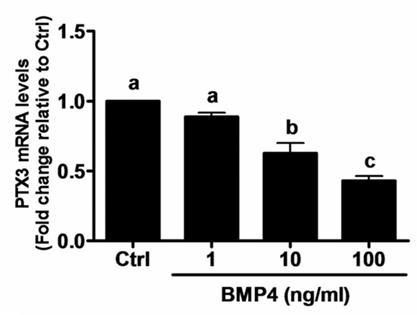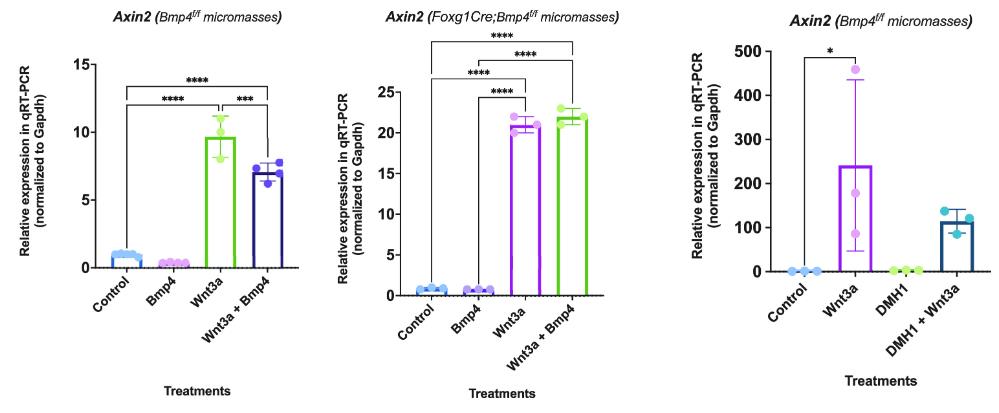BMP4
-
Official Full Name
bone morphogenetic protein 4 -
Overview
Bone morphogenetic protein 4 is a protein that in humans is encoded by BMP4 gene. BMP4 is a member of the bone morphogenetic protein family which is part of the transforming growth factor-beta superfamily. The superfamily includes large families of growth and differentiation factors. -
Synonyms
BMP4;bone morphogenetic protein 4;ZYME;BMP2B;OFC11;BMP2B1;MCOPS6;BMP-4;Bone morphogenetic protein 2B;BMP-2B;BMP2B, DVR4;OTTHUMP00000178992
Recombinant Proteins
- Human
- Mouse
- Zebrafish
- Rat
- Chicken
- Pig
- Rabbit
- Porcine
- Bovine
- E.coli
- CHO
- HeLa
- HEK293
- Mammalian Cells
- Mouse myeloma cell
- Human Cells
- NS0
- Yeast
- Non
- His
- Myc
- S
- GST
- T7
- rFc
- Fc
- Avi
- SUMO
- RbFc
Background
What is BMP4 protein?
BMP4 gene (bone morphogenetic protein 4) is a protein coding gene which situated on the long arm of chromosome 14 at locus 14q22. This gene encodes a secreted ligand of the TGF-beta (transforming growth factor-beta) superfamily of proteins. Ligands of this family bind various TGF-beta receptors leading to recruitment and activation of SMAD family transcription factors that regulate gene expression. The encoded preproprotein is proteolytically processed to generate each subunit of the disulfide-linked homodimer. This protein regulates heart development and adipogenesis. Mutations in this gene are associated with orofacial cleft and microphthalmia in human patients. The encoded protein may also be involved in the pathology of multiple cardiovascular diseases and human cancers. The BMP4 protein is consisted of 408 amino acids and BMP4 molecular weight is approximately 46.6 kDa.
What is the function of BMP4 protein?
BMP4 is expressed in a cell type-specific manner in various tissues and its expression can be detected in different patterns, such as negative, weak diffuse, moderate diffuse, or strong granular staining, which may suggest a secretory expression pattern. It is expressed during the organogenesis of the kidney, tooth, lung, and gut, as well as during skeletogenesis, limb patterning, and mammary gland development. BMP4 is essential for multiple developmental processes, including neurogenesis, vascular development, angiogenesis, and osteogenesis. It can modulate cell proliferation, differentiation, survival, migration, and even cell fate. BMP4 is crucial for normal embryonic development, and its homozygous deletion in mice results in embryonic lethality. BMP4 is involved in skeletal repair and bone regeneration processes. It also has a role in normal ovaries, endocrine pancreas, and spleen function, and has been implicated in idiopathic pulmonary fibrosis and certain types of cancer.
BMP4 Related Signaling Pathway
BMP4 activates Smad proteins, specifically Smad1, Smad5, and Smad8, by binding to its specific transmembrane receptors. These R-Smad (Receptor-regulated Smad) bind to Smad4 (Co-Smad) after phosphorylation and transport into the nucleus to regulate the transcription of target genes. BMP4 can also activate non-MAD dependent signaling pathways, such as the MAPK signaling pathway, including the ERK/MAPK, PI3K/Akt, or SRC cascade, which play a role in cytoskeletal remodeling, cell growth regulation, and cytoplasmic division. In addition, there is an interaction between BMP4 and Wnt signaling pathways. Activation of Hedgehog signaling pathway can affect the expression of BMP4, and both play a role in cell differentiation and tissue morphogenesis. Notch signaling pathway interaction exists in BMP4 signaling pathway; BMP4 can affect the physiological function of cells by activating MAPK signaling pathways, such as p38 MAPK.

Fig1. Fundamental mechanisms of canonical BMP superfamily signalling. (Valerie S Salazar, 2016)
BMP4 Related Diseases
BMP4 plays a crucial role in bone development, and its abnormal function can lead to various congenital bone malformations, such as Axenfeld-Rieger syndrome, which involves anterior segment malformations, increased intraocular pressure, and glaucoma. As a degenerative disease affecting articular cartilage, the abnormal expression of BMP4 may be related to the pathogenesis of osteoarthritis. BMP4 plays a role in promoting tumor growth and metastasis in certain types of cancer, including breast, lung, and prostate cancers. BMP4 is also involved in muscle and bone maintenance and repair, and abnormalities in its expression or function can lead to muscular dystrophy or other musculoskeletal disorders. It is also associated with cardiovascular disorders and neurological disorders.
Bioapplications of BMP4
Because of its key role in promoting cell differentiation and tissue regeneration, BMP4 has important applications in the fields of medicine and biotechnology. It is mainly used in tissue engineering to promote the repair and regeneration of bone, cartilage, skin and other tissues; In orthopaedics, BMP4 is used to accelerate fracture healing and treat bone defects. In spinal surgery, it helps fuse the vertebrae together. The dental field uses BMP4 to promote regeneration of periodontal tissue and alveolar bone. In addition, BMP4 has potential applications in drug screening, disease model research, gene therapy, cosmetic skin care, and cardiovascular disease treatment. In the field of tumor therapy, the study of BMP4 signaling pathway contributes to the development of new anticancer strategies.
Case Study
Case Study 1: Hsun-Ming Chang, 2015
Pentraxin 3 (PTX3) plays a critical role in the assembly of the cumulus oophorus extracellular matrix, which is essential for cumulus expansion during ovulation and may be modulated by BMP4 and BMP7. The aim of this study was to investigate the effects of BMP4 and BMP7 on the expression of PTX3 in human granulosa cells and to examine their underlying molecular determinants. PTX3 expression and accumulation as well as Smad1/5/8 phosphorylation were examined after exposure to recombinant human BMP4 and BMP7. BMP type I receptor involvement was investigated with inhibitors and small interfering RNAs targeting activin receptor-like kinase (ALK)2, ALK3, and/or ALK6. Small interfering RNAs targeting Smad4 were used to verify the involvement of Smad signaling. This study showed that BMP4 and BMP7 use differential subsets of BMP type I receptors to downregulate PTX3 expression via Smad-dependent signaling in human granulosa cells.

Fig1. BMP4 downregulates PTX3 expression in SVOG cells.

Fig2. BMP4 and BMP7 activate Smad1/5/8 signaling in SVOG cells.
Case Study 2: Natalia Bottasso-Arias, 2022
Tracheobronchomalacia and complete tracheal rings are congenital malformations of the trachea associated with morbidity and mortality for which the etiology remains poorly understood. Epithelial expression of Wls (a cargo receptor mediating Wnt ligand secretion) by tracheal cells is essential for patterning the embryonic mouse trachea's cartilage and muscle. RNA sequencing indicated that Wls differentially modulated the expression of BMP signaling molecules. Researchers tested whether BMP signaling, induced by epithelial Wnt ligands, mediates cartilage formation. Deletion of Bmp4 from respiratory tract mesenchyme impaired tracheal cartilage formation. Mesenchymal deletion of Bmp4 impaired expression of Wnt/β-catenin target genes, including targets of WNT signaling: Notum and Axin2. In vitro, recombinant (r)BMP4 rescued the expression of Notum in Bmp4-deficient tracheal mesenchymal cells and induced Notum promoter activity via SMAD1/5. RNA sequencing of Bmp4-deficient tracheas identified genes essential for chondrogenesis and muscle development coregulated by BMP and WNT signaling.

Fig3. Wnt3a-induced expression of Axin2 was attenuated by the cotreatment with rBMP4 and Wnt3a in control micromasses.

Fig4. Cotreatment of Wnt3a and rBMP4 increased luciferase activity compared with treatment with Wnt3a.
Quality Guarantee
High Purity
.jpg)
Fig1. SDS-PAGE (BMP4-24H)
.
.jpg)
Fig2. SDS-PAGE (BMP4-569H)
Involved Pathway
BMP4 involved in several pathways and played different roles in them. We selected most pathways BMP4 participated on our site, such as Hedgehog signaling pathway,TGF-beta signaling pathway,Hippo signaling pathway, which may be useful for your reference. Also, other proteins which involved in the same pathway with BMP4 were listed below. Creative BioMart supplied nearly all the proteins listed, you can search them on our site.
| Pathway Name | Pathway Related Protein |
|---|---|
| TGF-beta signaling pathway | E2F5,SMAD6,CHD,CUL1B,RBX1,RPS6KB1B,RHOAA,SMURF1,PITX2,ROCK1 |
| Basal cell carcinoma | FZD3,FZD6,BMP2,DVL3,SUFU,WNT7A,WNT6,LEF1,WNT1,WNT9B |
| Hedgehog signaling pathway | WNT7A,DYRK1A,CSNK1DB,FBXW11,GLI1,GSK3B,IHH,PRKACG,CSNK1G1,LRP2A |
| Hippo signaling pathway | RASSF1,ITGB2,MOBKL1A,BMP8A,FBXW11,MPP5,FZD2,TGFB3,TEAD3,WNT8A |
| Signaling pathways regulating pluripotency of stem cells | WNT10B,INHBC,KRAS,WNT11,KLF4,LHX5,MAPK12,JARID2,FZD1,ID1 |
| Pathways in cancer | MSH3,LAMB4,Fasl,WNT8A,TGFA,PRKACB,WNT6,KIT,FGF9,FGF6 |
| Thyroid hormone signaling pathway | MED4,PRKCG,ESR1,PLCG1,CCND1,RCAN1,RCAN2,PLCB1,HDAC1,STAT1 |
Protein Function
BMP4 has several biochemical functions, for example, BMP receptor binding,chemoattractant activity,co-receptor binding. Some of the functions are cooperated with other proteins, some of the functions could acted by BMP4 itself. We selected most functions BMP4 had, and list some proteins which have the same functions with BMP4. You can find most of the proteins on our site.
| Function | Related Protein |
|---|---|
| cytokine activity | IL5,IL34,IL16,LEFTY1,TNFSF11,TNFB,INHBAA,IL17A/F2,TIMP1,GRN |
| chemoattractant activity | CXCL12B,VEGFB,HMGB1,CXCL12A,PDGFB,HGF,SAA1,CCL16,VEGFC,SCG2 |
| BMP receptor binding | BMP8A,BMP7B,BMP2B,BMP5,PYCARD,BMP7A,BMP2,BMP6,BMP7,BMP8B |
| protein binding | CBX3,GATSL3,PRC1,HK2,NR1H4,RANBP2,GPR77,EPS15,CHCHD2,SMC6 |
| growth factor activity | INHBE,FGF1A,AGT,FGF12,PDGFD,IGF2A,IL3,MSTNA,HDGF,IGF3 |
| heparin binding | PDCD5,PTN,APOE,CXCL6,WISP1A,CHRD,ADAMTS3,FGF10,ADAMTSL5,LXN |
| co-receptor binding | NEO1,DKK1,BMP2,TFR2,HFE |
| protein homodimerization activity | BOKA,TCF4,STC2,MFF,EIF2AK1,CPOX,TFAP2B,TERF2,MUC13,NPR3 |
| transforming growth factor beta receptor binding | INHBC,INHBAB,GDF15,BMP7,GDF3,MSTNA,GDF10,GDF2,TGFBR3,USP15 |
Interacting Protein
BMP4 has direct interactions with proteins and molecules. Those interactions were detected by several methods such as yeast two hybrid, co-IP, pull-down and so on. We selected proteins and molecules interacted with BMP4 here. Most of them are supplied by our site. Hope this information will be useful for your research of BMP4.
BMPR1A;FSTL1;WFIKKN2;WFIKKN1;olfml3;chrd;ZFYVE9;C12orf60
Resources
Gene Families
Research Area
- BMPs and Regulators Secreted by Endothelial Cells
- Cardiac Stem Cell Markers
- Early Ectodermal Lineage Markers
- Early Mesodermal Lineage Markers
- Cytokines and Growth Factors Secreted by VSMC
- EMT Induction
- Neural Crest Cell Markers
- Ectodermal Lineage Markers
- Mesodermal Lineage Markers
- BMPs (Bone Morphogenetic Proteins)
Related Services
Related Products
References
- Arany, PR; Huang, GX; et al. Multi-lineage MSC Differentiation via Engineered Morphogen Fields. JOURNAL OF DENTAL RESEARCH 93:1250-1257(2014).
- Siddique, I; Curran, SP; et al. Gremlin Promotes Peritoneal Membrane Injury in an Experimental Mouse Model and Is Associated with Increased Solute Transport in Peritoneal Dialysis Patients. AMERICAN JOURNAL OF PATHOLOGY 184:2976-2984(2014).




